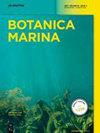波罗的海附生和自由生大藻褐藻(褐藻科)的系统地理格局
IF 1.4
4区 生物学
Q2 MARINE & FRESHWATER BIOLOGY
引用次数: 2
摘要
摘要利用线粒体基因间间隔序列和23S亚基的序列分析,探讨了墨角藻(Fucus vesiculosus)的系统地理分布模式。样本来自波罗的海6个亚盆地的21个地点。我们确定了一种假定的祖先线粒体单倍型,它从大西洋进入波罗的海,在整个物种分布中广泛殖民。这种单倍型的优势表现在总体单倍型多样性较低(Hd = 0.29)。此外,有迹象表明,在更深的人口时间尺度上,很少有空间聚集模式(Fct = 0.040;Fst = 0.049)。Tajima的D值(- 0.685,p值0.297)和Fu的FS值(0.267,p值0.591)未显示人口统计学极端变化的显著信号。波罗的海自由生活的Fucus被确认为f.s vesiculosus或其近缘种。单倍型多样性具有可比性(附Hd = 0.306;自由生活Hd = 0.268)。在相对较短的时间尺度上,加上Fucus线粒体基因组的低变异,导致整个波罗的海的结构相当泛海。我们的数据表明,线粒体基因间间隔和23S不能很好地描述墨角藻在如此年轻的冰川后环境中的进化动力学,但这种连接的条形码促进了我们对f.s vesiculosus在更深的人口统计时间尺度上的定殖动力学的理解。本文章由计算机程序翻译,如有差异,请以英文原文为准。
Phylogeographic patterns in attached and free-living marine macroalga Fucus vesiculosus (Fucaceae, Phaeophyceae) in the Baltic Sea
Abstract Sequencing of a mitochondrial intergenic spacer and 23S subunit was used to investigate the phylogeographic patterns in Fucus vesiculosus. Samples originated from 21 sites spanning six subbasins of the Baltic Sea. We identify a putative ancestral mitochondrial haplotype that entered the Baltic Sea from the Atlantic, colonising extensively throughout the species’ distribution. The dominance of this haplotype is seen in the low overall haplotype diversity (Hd = 0.29). Moreover, there is indication of few spatially aggregated patterns in the deeper demographic time scales (Fct = 0.040; Fst = 0.049). Tajima’s D (−0.685, p-value 0.297) and Fu’s FS (0.267, p-value 0.591) showed no significant signals of extreme demographic changes. The Baltic Sea free-living Fucus is confirmed as F. vesiculosus or a closely related species. Haplotype diversities are comparable between forms (attached Hd = 0.306; free-living Hd = 0.268). The relatively short temporal scale for colonisation alongside low variance in the Fucus mitochondrial genome results in a rather panmictic structure across the Baltic Sea. Our data suggest that the mitochondrial intergenic spacer and 23S poorly describe the evolutionary dynamics of Fucus spp. in such a young, postglacial environment, yet this concatenated-barcode advances our understanding of the colonisation dynamics of F. vesiculosus over deeper demographic timescales.
求助全文
通过发布文献求助,成功后即可免费获取论文全文。
去求助
来源期刊

Botanica Marina
生物-海洋与淡水生物学
CiteScore
4.10
自引率
4.50%
发文量
43
期刊介绍:
Botanica Marina publishes high-quality contributions from all of the disciplines of marine botany at all levels of biological organisation from subcellular to ecosystem: chemistry and applications, genomics, physiology and ecology, phylogeny and biogeography. Research involving global or interdisciplinary interest is especially welcome. Applied science papers are appreciated, particularly when they illustrate the application of emerging conceptual issues or promote developing technologies. The journal invites state-of-the art reviews dealing with recent developments in marine botany.
 求助内容:
求助内容: 应助结果提醒方式:
应助结果提醒方式:


